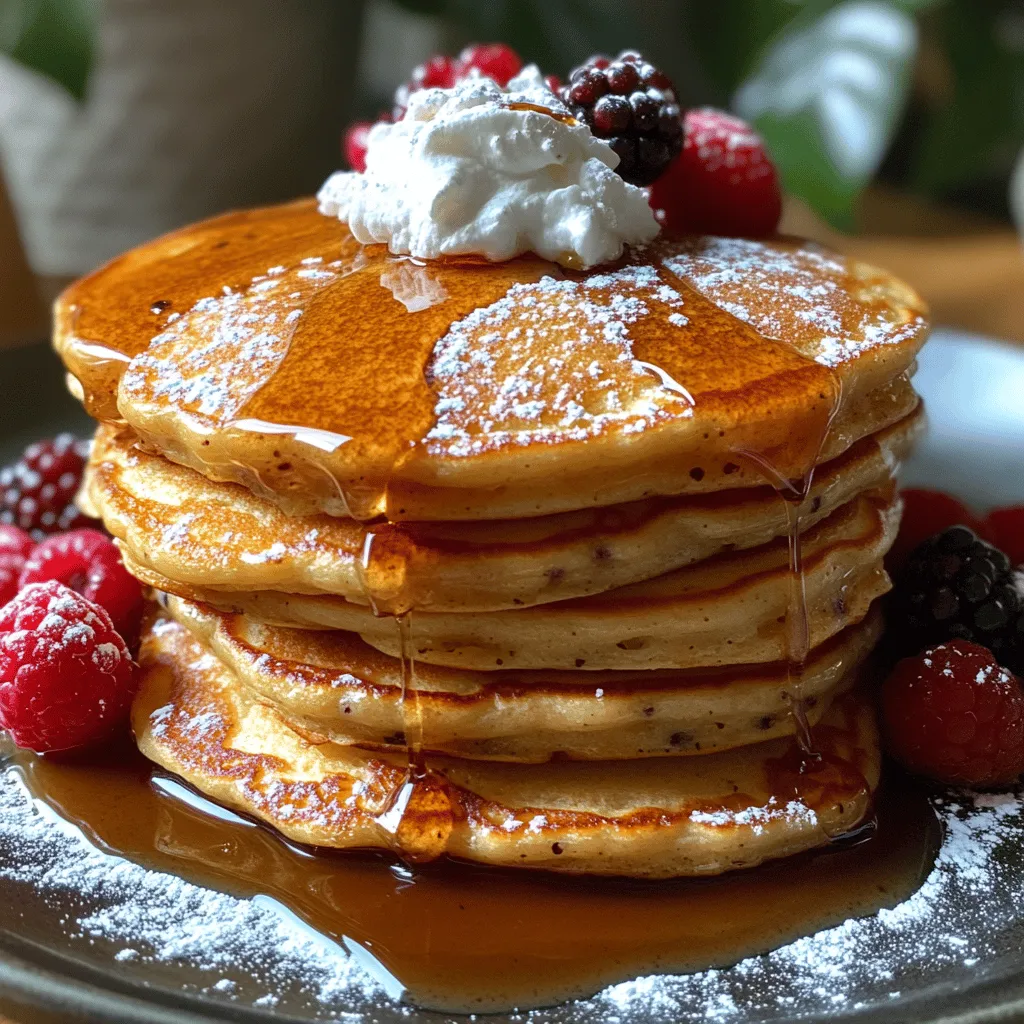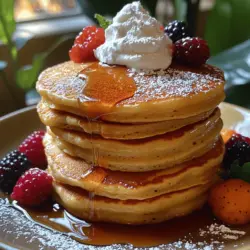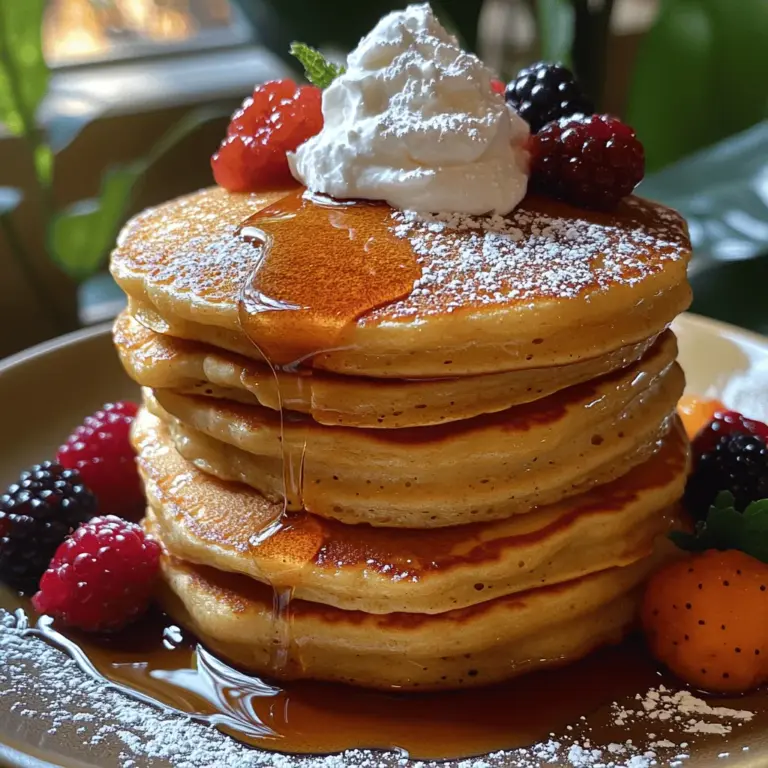Introduction
Pancakes have long been celebrated as a beloved breakfast staple across cultures, cherished for their versatility and comforting nature. From classic Saturday morning breakfasts to gourmet brunches, pancakes have always held a special place in our hearts and stomachs. However, the secret to a truly memorable pancake lies in achieving that perfect fluffy texture—light, airy, and just the right amount of golden brown. This is where buttermilk comes into play, transforming ordinary pancakes into a culinary delight.
Buttermilk pancakes stand apart from their traditional counterparts, presenting a unique flavor profile and texture that is hard to resist. The tanginess of buttermilk, paired with the right balance of ingredients, creates a pancake that is not only delicious but also incredibly fluffy. While many might settle for store-bought pancake mixes for convenience, nothing beats the satisfaction and taste of homemade pancakes. With just a few simple ingredients and a bit of technique, you can whip up a stack of fluffy buttermilk pancakes that will bring smiles to the breakfast table.
Understanding Buttermilk and Its Role in Pancakes
To appreciate the magic of buttermilk pancakes, it’s essential to understand what buttermilk is and how it works in baking. Traditionally, buttermilk is the liquid left behind after churning cream into butter. This tangy, slightly acidic liquid is a staple in many kitchens and is widely used in various dishes, from dressings to marinades. In the realm of baking, buttermilk is revered not just for its flavor but also for its role in creating tender and moist baked goods.
The science behind buttermilk’s effect on pancake texture is fascinating. The acidity in buttermilk interacts with leavening agents such as baking powder and baking soda, promoting a chemical reaction that produces carbon dioxide gas bubbles. These bubbles are what help pancakes rise and develop that coveted fluffy texture. When combined with flour, the proteins in the buttermilk also help to create a tender crumb, ensuring that each bite of pancake is soft and inviting.
When comparing buttermilk pancakes to traditional pancakes made with regular milk, the difference is palpable. Buttermilk pancakes tend to be thicker and fluffier, with a richer flavor that enhances the overall pancake experience. The tang from the buttermilk complements the sweetness of the syrup, making each bite a delightful dance of flavors.
Ingredients Breakdown
To create the perfect fluffy buttermilk pancakes, it’s important to understand the role of each ingredient in the recipe. Below is a detailed description of the essential ingredients that contribute to the pancake’s delightful texture and taste:
All-Purpose Flour
All-purpose flour serves as the backbone of the pancake batter, providing structure and texture. It contains a moderate amount of protein, which is crucial for gluten development. When mixed with liquid, the flour forms a gluten network that helps trap air during cooking, resulting in fluffy pancakes. For the best results, it’s recommended to sift the flour before measuring to ensure an even distribution and to prevent clumping.
Granulated Sugar
Granulated sugar not only enhances the flavor of the pancakes but also contributes to browning during cooking. The Maillard reaction, which occurs when sugar is heated, leads to that beautiful golden-brown crust we all love. While sugar is generally added for sweetness, it also helps retain moisture in the batter, promoting a soft texture.
Baking Powder and Baking Soda
These two leavening agents are key players in achieving the perfect rise in pancakes. Baking powder contains both an acid and a base, allowing it to produce carbon dioxide gas when mixed with liquid. This gas creates air pockets in the batter, promoting fluffiness. Baking soda, on the other hand, requires an acid (such as buttermilk) to activate. When combined, these leavening agents work synergistically to ensure that each pancake puffs up beautifully on the griddle.
Salt
Though it may seem like a small addition, salt plays a significant role in enhancing the flavors of the pancakes. It acts as a flavor enhancer, bringing out the sweetness of the sugar and the richness of the buttermilk. Additionally, salt helps regulate the fermentation process when using yeast in other recipes, though it’s not as critical for pancakes.
Buttermilk
The star ingredient of this recipe, buttermilk, contributes moisture and a subtle tanginess that elevates the pancakes. Its acidity not only aids in the leavening process but also helps to break down the gluten in the flour, resulting in a tender, fluffy texture. For those who don’t have buttermilk on hand, a simple substitute can be made by mixing regular milk with a tablespoon of vinegar or lemon juice and allowing it to sit for a few minutes before using.
Egg
Eggs play a crucial role in pancake recipes. They act as a binding agent, holding the ingredients together and adding richness to the batter. The proteins in the egg help create structure, while the fats contribute to a moist and tender crumb. For the best results, use room-temperature eggs to ensure they incorporate smoothly into the batter.
Unsalted Butter
Unsalted butter adds flavor and moisture to the pancake batter. It also aids in browning, contributing to the delicious golden crust on the pancakes. Using unsalted butter allows for better control over the overall saltiness of the recipe. Be sure to melt the butter and allow it to cool slightly before adding it to the batter to avoid cooking the eggs.
Vanilla Extract
Vanilla extract is the finishing touch that enhances the aroma and sweetness of the pancakes. It adds a warm, inviting flavor that pairs beautifully with the buttermilk and sugar. Using pure vanilla extract is recommended for the best flavor, though imitation vanilla can also be used as a more cost-effective option.
Step-by-Step Instructions for Perfect Pancakes
Now that we have a clear understanding of the ingredients and their roles in creating fluffy buttermilk pancakes, it’s time to dive into the preparation process. Follow these step-by-step instructions to ensure your pancakes turn out perfectly every time.
Preparation of Dry Ingredients
1. Measure and Sift the Flour: Start by measuring out the all-purpose flour using the spoon-and-level method to avoid packing it into the measuring cup. Sift the flour into a large mixing bowl to aerate it and remove any lumps. This step is essential for achieving a light and fluffy texture.
2. Combine the Dry Ingredients: In the same bowl, add the granulated sugar, baking powder, baking soda, and salt. Whisk these dry ingredients together until they are evenly combined. This ensures that the leavening agents are distributed throughout the flour, which is crucial for even rising and texture.
Mixing Wet Ingredients
3. Prepare the Wet Ingredients: In a separate bowl, combine the buttermilk, eggs, and melted unsalted butter. If you desire, add a splash of vanilla extract for an extra layer of flavor. Whisk the wet ingredients together until they are well blended. Make sure the melted butter has cooled slightly before adding it to prevent cooking the eggs.
4. Combine Wet and Dry Ingredients: Create a well in the center of the dry ingredients and pour in the wet mixture. Using a spatula or wooden spoon, gently fold the two mixtures together. Be careful not to overmix; it’s perfectly okay if there are a few lumps remaining. Overmixing can lead to tough pancakes, so aim for a batter that is just combined.
The next steps will focus on cooking the pancakes to perfection, ensuring they are fluffy, golden, and ready to serve with your favorite toppings. Stay tuned for the continuation, where we’ll cover how to properly cook your pancakes and serve them to delight your family and friends.

Tips for Achieving a Smooth Mixture
Creating a perfect batter is essential for fluffy buttermilk pancakes. Here are some tips to ensure your mixture is smooth and free of lumps:
1. Sift Dry Ingredients: Always sift your flour, baking powder, baking soda, and salt together in a bowl. This process aerates the flour and helps to break up any clumps, leading to a smoother batter.
2. Room Temperature Ingredients: Use room temperature buttermilk and eggs. Cold ingredients can cause the batter to thicken and clump, preventing it from being smooth. Allow these ingredients to sit out for about 30 minutes before mixing.
3. Gentle Mixing: When combining the wet and dry ingredients, use a whisk or spatula. Stir gently until just combined. It’s normal for the batter to be slightly lumpy; overmixing can lead to dense pancakes.
Combining Mixtures
Combining your wet and dry mixtures correctly is crucial for fluffy pancakes. Pour the buttermilk mixture into the bowl containing the dry ingredients. Use a spatula to fold the mixtures together gently. Aim for a uniform batter without overworking it.
Highlighting the Significance of Not Overmixing
One of the most critical steps in pancake-making is ensuring you don’t overmix the batter. Overmixing activates the gluten in the flour, resulting in tough, chewy pancakes instead of the desired lightness. Stir just until you no longer see dry flour. A few lumps are perfectly fine and will disappear during cooking.
Preheating the Pan
Preheating your pan or griddle is essential for achieving golden-brown pancakes. Heat your non-stick skillet or griddle over medium heat for about 5 minutes. To check if it’s ready, sprinkle a few drops of water onto the surface; they should sizzle and evaporate immediately. If they just sit there, the pan isn’t hot enough.
Optimal Cooking Temperature for Fluffy Results
Cooking pancakes at the right temperature is key to their fluffiness. If the heat is too high, the pancakes will burn on the outside while remaining raw on the inside. Conversely, too low of a temperature will result in pancakes that are pale and undercooked. A medium heat setting is usually ideal, but adjust as necessary based on your cooking surface.
Cooking the Pancakes
When you’re ready to cook, lightly grease the pan with a bit of butter or cooking spray. Pour about 1/4 cup of batter onto the skillet for each pancake.
Visual Cues to Look for When Flipping Pancakes
The best time to flip your pancakes is when small bubbles start to form on the surface, and the edges appear set. This usually takes about 2-3 minutes, depending on your heat settings. Use a spatula to gently lift the edge of a pancake to check for a golden-brown color before flipping.
Importance of Keeping Pancakes Warm While Cooking
As you cook your pancakes in batches, it’s vital to keep the finished ones warm. Preheat your oven to 200°F (93°C) and place a baking sheet inside. As each pancake is cooked, transfer them to the warm oven. This step ensures they stay warm and fluffy until you’re ready to serve.
Serving Suggestions and Toppings
Once your fluffy buttermilk pancakes are cooked to perfection, it’s time to serve them up! Here are some delightful ideas:
Ideas for Serving the Pancakes
1. Classic Maple Syrup and Butter: A traditional favorite, drizzle warm maple syrup over a stack of pancakes and add a pat of butter on top for that irresistible melt.
2. Fresh Fruits: Top with a medley of fresh berries—strawberries, blueberries, or raspberries—or sliced bananas. Seasonal fruits can also add a delightful twist, so feel free to get creative with your toppings.
3. Whipped Cream and Other Indulgent Toppings: For a special treat, add a dollop of whipped cream or even a scoop of vanilla ice cream on top of your pancakes. Sprinkle with chocolate shavings or nuts for extra texture.
Creative Variations to Customize Pancakes
– Adding Chocolate Chips or Nuts to the Batter: Fold in chocolate chips, walnuts, or pecans into the batter before cooking for added flavor and texture.
– Infusing Flavors with Spices: For a warm, comforting twist, consider adding spices like cinnamon or nutmeg to the batter. Approximately 1/2 teaspoon of cinnamon can elevate the flavor profile significantly.
Nutritional Information
Pancakes can be a delicious breakfast option, but it’s essential to consider their nutritional content.
Overview of Nutritional Benefits of Pancakes
A standard buttermilk pancake contains roughly 150 calories, 4 grams of fat, 25 grams of carbohydrates, and 4 grams of protein. The exact nutritional makeup can vary based on portion size and specific ingredients used.
Considerations for Dietary Preferences
Those with dietary restrictions can still enjoy pancakes:
– Gluten-Free Alternatives: Use gluten-free all-purpose flour or almond flour for a gluten-free version. Be sure to check that your baking powder is also gluten-free.
– Dairy-Free Options: Substitute buttermilk with almond milk or oat milk and use a dairy-free butter alternative.
Conclusion
Making fluffy buttermilk pancakes is not only a culinary delight but also a wonderful way to bring joy to your breakfast table. The process of crafting them from scratch can be incredibly satisfying, and the aroma that fills your kitchen is simply irresistible.
We encourage you to try this recipe and experiment with different variations to make it your own. Whether you prefer classic maple syrup or a creative topping, the comfort of homemade pancakes is unmatched. Embrace the joy of cooking and savor the satisfaction of enjoying a stack of fluffy buttermilk pancakes with family and friends. Happy cooking!

